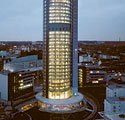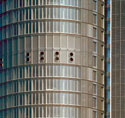Commercial Buildings Open Their Windows
The design team began the project with a low-tech strategy, determining the best siting for the most sunlight. This was accomplished with a strict north-south orientation. The footprints for eight 36-foot-long growing zones, occupying 36,000 square feet, were then sited so that their long axis is exactly oriented to solar north in order to capture maximum incident sunlight.
The greenhouse units are modular, steel-framed trussed structures with glass roofs and side and end walls. The Nolan Greenhouses use the "greenhouse effect" (capturing and retaining incident solar radiation) to good purpose. The glazing-1¼4-inch tempered glass in most areas-captures the sun's heat in the winter and stores it in massive concrete floors and knee walls. Whereas solar radiation alone is not sufficient to maintain the proper growing conditions, this glass allows enormous heat gain and maximum light with almost no filtering. While this seems counterintuitive when compared to projects involving the comfort of humans, it certainly qualifies as a sustainable maneuver, because it is both energy efficient and meets the requirements of a particular demand, in this case, plants.
The greenhouses feature operable roofs, a technology pioneered by greenhouse manufacturer Van Wingerden. "When it is necessary to release all that captured solar heat in order to maximize ventilation, each roof section can be opened by electric rack-and-pinion motors operated through the environmental control system," says Braddock, unveiling the complexity of the HVAC's high-tech functions. When temperature sensors in a zone indicate that cooling is required (based on criteria programmed into the environmental control system by the greenhouse operators), the roof of that zone is automatically opened. Each zone consists of three ridges with two roof vents per ridge. Each pair of roof vents is operated in tandem by a single motor.
The ability to open the entire glass roof of each unit when the weather is appropriate facilitates "hardening off" (the process by which plants grown in the idealized conditions of a greenhouse are gradually introduced to the variable conditions of the outdoors, in order to make them strong, hardy, and ready to be planted outside) without having to move them outdoors. Furthermore, the fact that they open means that heat removal does not require energy-depleting air-conditioning. When the roofs open perpendicular to the ground, they create a striking architectural profile.
Overheating is prevented by motor-driven curtains and evaporative cooling. Water is pumped over porous pads that hang along the north end of each zone. Outside air is drawn over the cooled pads and then exhausted out the south end by fans. Some zones are further cooled by mist that is automatically injected into the space and circulated by fans. Both methods are much less energy consuming than traditional air-conditioning.
During winter months and at night during spring and fall, energy-efficient hot-water radiant heating is provided for each of the growing zones. Water heated in boilers in the mechanical room is circulated by pipes embedded in the concrete floors, on the side walls, and under the glass roofs. According to the manufacturers, this consumes less energy than traditional forced hot air or radiators.
The Nolen Greenhouses provide a textbook case study about HVAC challenges in extreme conditions. And yet, there are lessons for human occupancy of buildings. As all the projects here show, heating, cooling, and ventilating do not require the highly mechanized, energy-devouring machinery that we take for granted.











